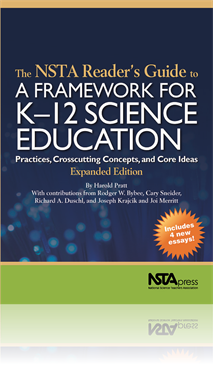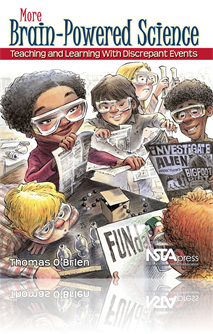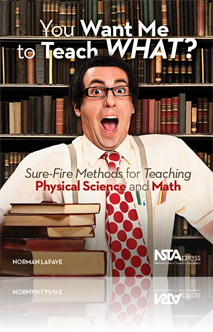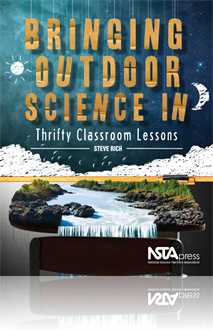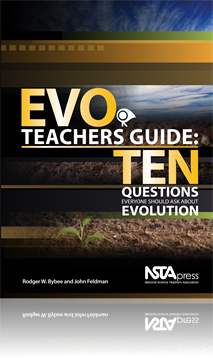All Book Chapters
Book Chapter
Dimension 3: Disciplinary Core Ideas: Physical Sciences
This chapter reviews how the physical science section has been organized under the following four core ideas and 13 component ideas. This sample chapter also includes the Table of Contents and Index. ...
Book Chapter
Archimedes, the Syracuse (Sicily) Scientist: Science Rules Balance and Bathtub Basics
Learners, in this activity, are guided to discover simple, quantitative relationships that support their qualitative observations of playing on seesaws (with different-size children) and taking baths....
Book Chapter
Medical Metaphor Mixer: Modeling Infectious Diseases
This model-building activity helps learners visualize SI’s base-ten relationships; the connections between the meter, liter, and gram; the real-world relevance of mathematics to science; and the somewhat abstract concept of powers of ten that is so...
Book Chapter
A teacher’s success in instructing teenagers is substantially enhanced the more the teacher understands teenagers. Between brain development, changing hormonal makeup, and environmental stimuli, there can be no doubt about what adults have known fo...
Book Chapter
Conquering Culture and Psychology
Students bring their own experience base to the classroom, and it may diverge greatly from that of the teacher. This makes it extremely important that teachers make an effort to understand the community in which they teach and the experiences student...
Book Chapter
Yes, Virginia, Study Habits and Learning Techniques Are Key!
Teachers like to point out in discussions pertaining to higher-order thinking that their students often struggle with lower-order thinking. Their point is well taken. There has been a trend away from making students memorize material. For example, th...
Book Chapter
From Concepts to Principles to Processes to Equations
There is a tendency for students to misunderstand order and priorities when learning advanced mathematics and physical science. Many times students become so focused on the equations that they fail to comprehend the concepts and principles that under...
Book Chapter
Doing Calculations the Right Way
Observing a student trying to solve a word problem can often be a frustrating experience for the teacher. The secret to getting students to learn processes is to set their perspective. They need to look at problems differently than their initial view...
Book Chapter
How to Analyze: Building the Perfect Laboratory Rat
Mastering analytical thinking is equally important to problem-solving proficiency for students’ enrichment and their preparation for professional careers. Analytical thinking is one of the top three categories in Bloom’s taxonomy, and mastery of ...
Book Chapter
OK, Now All My Students Will Love Science and Math, Right?
In math and science, maybe more than any other subjects, it is important that teachers be realistic and refrain from blaming themselves for all failures. This is counterproductive and takes time away from constructive efforts. This does not suggest t...
Book Chapter
But I Still Don't Feel Comfortable Teaching This
Many teachers will find themselves teaching upper-level subjects they do not feel adequately prepared to teach. In smaller schools, there may even be an inadequate staff to provide support to these teachers. With the shortage of science and mathemati...
Book Chapter
For no other reason than their sheer numbers, insects warrant a chapter in a book on outdoor science. Many species of insects have survived for millions of years, and in some ways remain unchanged. They are a real success story in the natural world. ...
Book Chapter
Life on Earth as we know it is dependent on plants. This chapter will help you provide some of these initial experiences for students, but these lessons certainly do not constitute a complete unit on the plant kingdom. In each lesson, students will m...
Book Chapter
Where does water go when it flows down a river? Can water move land? What is the most effective way to use water to grow plants? These are just a few of the questions that students can explore with the lessons in this chapter. No matter how “deep�...
Book Chapter
The lessons in this chapter touch on the major topics that can be addressed on this subject, but they only represent a small portion of what can be accomplished through engaging students in thoughtful observations of both the day and night skies. The...
Book Chapter
The lesson, in this chapter, engages students in the concepts and processes of biological evolution. It also introduces the EVO DVD. The lesson begins by viewing Question 1 of the DVD, which introduces the World Summit on Evolution and asks the quest...
Book Chapter
Why Should Anyone Care About Evolution?
This chapter is designed as a final evaluation and serves as a culmination for EVO. Students are asked to develop an argument for evolution. The lesson begins with the question, Why should anyone care about evolution? Students present their ideas. T...
Book Chapter
This chapter begins by asking students the questions, Who was Charles Darwin? and What do you know about him? After collecting students’ current knowledge about Darwin, the EVO DVD provides background on the explorations and experiences that result...
Book Chapter
This chapter uses an invitation to inquiry strategy to answer the question, What is natural selection? The students are engaged by a problem of a farmer trying to eliminate flies from a barn. Students explore reasons for the return of the flies. This...
Book Chapter
The lesson, in this chapter, begins with the concept of species. Students have a general understanding of what species are. They know, for example, that an evergreen and an oak tree are two different types (i.e., species) of trees. However, scientist...
Book Chapter
Where Do Variations Come From?
This chapter begins with students observing genetic variations within a population they know well: their own populations. They confront the question, How can you explain the variations? The EVO DVD provides an overview of the origin of genetic variat...
Book Chapter
What Role Does Cooperation Play?
The lesson, in this chapter, begins by asking students to think of a situation where they both compete and cooperate. They then identify a team sport such as basketball or volleyball to explore the theme of cooperation. The EVO DVD explains that coop...
Book Chapter
What Is a Brief History of Life?
Most students have problems with the scale of geologic and evolutionary time. This lesson helps students understand the scale of geologic time and the evolution of life. Students try to figure out something within their understanding that equals one ...
Book Chapter
The lesson, in this chapter, begins with students sharing with one another their views about evolution. The EVO DVD presents the controversy. Students then write one paragraph titled “Biological Evolution: What Is the Controversy?” The major aim ...
Book Chapter
This lesson centers on three ideas—randomness, patterns, and purpose—as they relate to natural phenomenon in general and biological evolution in particular. As these are relatively complex ideas, the lesson uses observable patterns in nature as a...
Book Chapter
By observing and discussing the characteristics of an insect, students will be able to identify the physical characteristics of an insect and explain that insects come in a variety of forms, colors, and adaptations. ...
Book Chapter
Students use small containers to follow scent trails that end at a field or alternative final destination. At the end of this activity, students will be able to describe how and why insects use their sense of smell for pheromone communication....
Book Chapter
As students listen, imitate, and identify the sounds of insects, students will be able to recognize and identify the sounds insects make. They will also be able to explain that insects call to communicate....
Book Chapter
Water Bugs: Insects as Indicators
Students, in this activity, will be able to determine the health of a body of water through investigation and inquiry. Students will be able to describe insects found in water using a hand lens and a microscope....
Book Chapter
In this activity, students research interesting things about insects or things found around an insect habitat, like a field or garden, to write a journalism-style story describing the events at an insect habitat. ...
Book Chapter
Students, in this activity, will be able to observe broadly and focus closely to discover seasonal changes taking place within a local habitat. Then students will act as naturalists spending time documenting their observations by writing and sketchin...
Book Chapter
In this activity, students will be able to create art that depicts insects. They will research and present information about the insect they chose to depict....
Book Chapter
By having students role-play the responsibilities of bees to create a simulation of a honeybee hive. Students will be able to understand the structure of a honeybee hive and how different types of bees help the hive function. This sample chapter als...
Book Chapter
Students will be able to identify and describe the points of view of different citizens in a fictitious community dilemma and express opinions about competing theories in this activity. Students will be able to develop an understanding of how communi...
Book Chapter
Students, in this activity, will be able to examine and discuss their own values around real-life environmental scenarios that involve insects....
Book Chapter
In this activity, students will be able to identify the behaviors of insects in their natural habitat by having the students explore the world around them. ...
Book Chapter
Students, in this activity, create a list of living and nonliving things found within a field habitat and discuss their relationships, through the creation of a simulated web using a ball of yarn. At the end, students will be able to describe the liv...
Book Chapter
Students, in this activity, learn the life cycle of an insect from egg to adult through discussion and acting out their growth stages....
Book Chapter
By comparing and contrasting the similarities and differences between insects using T-Charts and Venn diagrams, students will be able to identify the similarities and differences between insects and other species as they compare and contrast two diff...
Book Chapter
In this activity, students describe and demonstrate the basic act of pollination and the characteristic movements of honeybees and other insects through a relay race. ...



